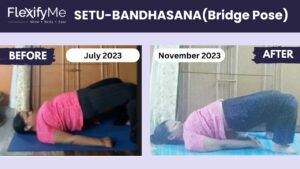Are you having back pain lately? At a particular age, we experience several body pains, and most of us don’t even pay attention to them. But that can take a toll on your life in your later years. Thus, you must identify the pain and treat it at the right time. Sciatica is a common back pain that can impact the quality of your life.

In the case of sciatica, a sharp pain travels from your lower back to the legs, causing numbness or inflammation. This pain generally occurs when a herniated disc or a bone overgrowth puts pressure on the lumbar spine nerve roots. So, how can you reduce this pain? There are various natural remedies that you can use to reduce sciatica pain. One such remedy is yoga for sciatica, which helps reduce the pain levels you’re experiencing. Sciatica pain is not rare. Utilising physiotherapy for sciatica can also release muscle tension, reducing the condition’s root cause.
Millions of people around the world suffer from sciatica. Unfortunately, most of them live with the pain because they’re unaware of the benefits of yoga therapy for sciatica and physiotherapy sessions. So, if you’re experiencing such pain, don’t live with it; just leave out of it!
Here is a sought-after guide on sciatica physiotherapy treatment and yoga therapy to prevent sciatica pain. Let’s begin…
What Causes Sciatica?
Before you get started with the sciatica yoga poses and physiotherapy exercises, understand what causes this pain. Sciatica refers to the sharp pain that originates in the lower back and travels through the leg, causing a sensation. Sciatica pain occurs when the spine nerve roots are under compression. The common causes of sciatica are:
- Slipped disc
- Degenerative disc disease
- Spondylolisthesis
- Spinal stenosis
- Accident or injury
- Obesity
Physiotherapy For Sciatica Relief

Sciatica physiotherapy exercises strengthen and stabilise tissues in the abdominals, buttocks and thighs. In treating sciatica pain, the aim of physiotherapy is to:
- Reduce muscle spasm
- Recover painless functioning movement patterns
- Nurture a better healing process for the lower back
- Relieves pain in the lower back, buttocks, thighs and legs
- Stimulate neuronal changes to minimise pain perception
- Boosts mobility of the lower body
- Eliminate future pain flare ups and lessen anxiety about mobility
Book a free demo for physiotherapy sessions and online yoga and relieve yourself from this pain.
Effective Physiotherapy Exercises For Sciatica Relief
You can get relief from sciatica by combining physical, manual and soft tissue mobilisation and/or exercise therapies. Depending on the level of pain, the causes of sciatica and your overall health condition, you need to choose the necessary techniques.
Here are some physiotherapy exercises/techniques to avoid sciatica pain.
1. The McKenzie Method (mechanical diagnosis and therapy)
The McKenzie method is a physiotherapy management of sciatica that uses a series of active, directed movements to locate and treat sciatica pain. This therapy focuses on transferring radiating pain closer to the centre of the body through movements such as bringing leg discomfort closer to the spine. The premise behind this method is to centralise the pain, leading to symptom relief.
2. Extension and Flexion Back Exercise
This physiotherapy workout alleviates discomfort by encouraging spine mobility. Specific directional movements often help individuals to get relief from lower back pain and sciatica. By analysing an individual’s directional preference, experts provide particular directional exercises customised to the patient’s complaints. These workouts incorporate both backward (extension) and forward (flexion) bending.
3. Strengthening Exercises
Strengthening exercises use body weight and resistance to enhance abdominal muscles, thighs, hips, lower back and legs. Strengthening exercises can be isometric workouts and isotonic workouts.
- Isometric workouts: These workouts focus on tightening the muscles without moving joints. Strengthening exercises include bridge hold and plank. When you experience severe sciatica pain symptoms, utilising these exercises might improve your muscles in the lumbar region.
- Isotonic workouts: These workouts include contracting a muscle to resist continual load, for instance, weight training and resistance bands. This exercise aids in strengthening your muscles by persistent resistance to certain movements.
4. Functional Retraining
This physiotherapy exercise entails reintroducing actions like carrying, bending, lifting or squatting. With proper training and appropriate movement patterns, this technique can relieve sciatica pain and prevent future pains.
Sign up today and heal your lower back and sciatica pain!
Yoga For Sciatica Pain Relief
Yoga benefits people who suffer from chronic sciatica pain. Sciatica pain relief yoga does not include quick or heavy movements. Rather, it involves gradual stretching and strengthening of muscles. Specific yoga asanas like moderate seated poses, forward bend poses, and backbends aim to keep the spinal nerve root healthy and flexible. Once you get it, you should continue practising the sciatica yoga poses even after your pain subsides to strengthen the remaining supporting muscles, including the pelvic, abdominal, and back muscles.
Effective Yoga Poses For Sciatica Relief
Misalignment of the lower back causes pressure on the sciatica nerve. The misalignment is usually caused by a gradual bad posture. Excessive sitting and slouching can cause tight hip flexors, hamstrings and glutes. In addition, it leads to a muscular imbalance between the abdominal and lower back muscles. To reduce discomfort on the intervertebral discs, it is essential to restore the curve of the lower back.
By following some yoga poses, you can release the tension in the muscles that causes sciatica pain. These poses will also assist in rebalancing and strengthening the relevant muscle groups in the body.
Here are some yoga poses to avoid for sciatica.
1. Cobra Pose (Bhujangasana)
This yoga posture supports and stretches your lumbar region, promoting circulation and flexibility. To do this sciatica yoga, you need to:
- Lie on your stomach, keeping your hands under the shoulders.
- Press the elbows inside the body.
- Inhale and lift your head, following the chest and shoulders.
- Retain a slight bend in your elbows, keeping your chest open.
- Engage your thighs, hip and abdominals.
- Maintain that position for up to 30 seconds.
- Ease the position, relax and repeat 1-3 times.
2. Bridge Pose (Setu Bandha Sarvangasana)
The bridge pose extends the backbone, which reduces pain and tension. This sciatica yoga gently stimulates the body, boosting circulation. Additionally, this pose exercises your core muscles, legs and glutes. Performing this yoga pose involves the following steps.
- Start this beginner yoga for sciatica by lying on your back with your knees bent and legs inward to the hip.
- Align your arms and body with palms facing downward.
- Lift your back slowly from the floor and raise your hips as high as possible.
- While raising your hips, you can place a block between your thighs or knees to ensure a balanced posture.
- Lower your back slowly.
- Repeat the pose at least 10 times.
- Relax your body in the beginning posture.
- Hold the pose at the highest position for up to 1 minute.
3. Half Moon Pose (Ardha Chandrasana)
The best yoga for sciatica is the half-moon pose, which strengthens, stabilises and balances the body. This yoga pose helps people reduce stress and stretches the spine, thighs and glutes. If you’re a beginner, take the support of a wall while doing this yoga asana. You can also put a block under your hand for assistance. Following are the steps to practise the half-moon pose.
- Stand in a triangle position, putting your right foot in the front.
- Bend your right knee slightly further and shift your body weight to the right foot.
- Move your left hand toward the hip.
- Lift your left foot forward a few inches and then stretch your right hand to the floor in front and to the right of your right foot.
- Elevate your left leg parallel to the floor and press out through the left heel.
- While looking ahead, rotate your torso and hips wide.
- Lift your left hand up toward the ceiling and look upward.
- You need to stay in this pose for up to 1 minute.
- While relaxing your left leg, bend your right leg and gradually return to the starting position.
- Repeat the same on the other side.
4. Child’s Pose (Balasana)
Child’s pose is a yoga for sciatica, which is a great way to connect with and relax your body. It grows and extends your spine, increasing flexibility and openness in your lower back, hips and thighs. If you require additional support, you can place a pillow or bolster under your forehead, chest and legs. This yoga pose needs you to:
- Bring your hands and knees together and lower your hips back to your heels.
- Stretch your arms frontward and let them rest beside your body.
- Relax your body entirely as you sink down towards your thighs.
- Take deep breaths to release any tightness or sensations.
- Maintain this position for about 5 minutes.
5. Locust Pose (Salabhasana)
Locust pose strengthens the thighs, glutes and spine. It also tightens your core and lower back to improve circulation in the lumbar region, ensuring flexibility. To practise this yoga asana, follow these steps:
- Lie on your stomach while interlocking your fingers and the base of the spine.
- Slowly raise your head, arms and torso as high as you can.
- Lift your arms up and away from your body.
- For a deeper impact, you can elevate both legs together or one leg at a time.
- Target your glutes, lower back and abdominals.
- Hold the pose for up to 30 seconds.
- Loosen the asana and return to the starting position.
- Rest and relax your body for a few minutes, and then slowly move your hips from side to side.
- Repeat this yoga pose 1-2 times.
6. Downward-Facing Dog
This yoga pose helps with your body alignment. To reduce sciatica pain and other discomforts, this is an ideal yoga asana. If you’re considering this position, you can:
- Start with your hands and knees. Lift your hip towards the sky, pressing onto your hands.
- You need to bring your ears in line with your upper arms or tuck your chin all the way in towards your chest by lowering your head.
- Bend your knees, tilting your pelvis slightly forward.
- Move your body freely in whatever way it seems natural.
- Hold the position for about a minute.
7. Reclined Pigeon Pose (Supta Kapotasana)
Doing a pigeon pose on your back supports your lower back and relieves pressure on your hips. The reclined pigeon pose stretches your piriformis muscle, glutes and hips. To perform this pose, you need to:
- Lie your back, bend your legs and move your heels toward the hips.
- Bend your right knee and place the right ankle at the bottom of your left thigh.
- Stay in that position if you’re feeling a deep stretch already.
- To go further, raise your left foot and bring your left knee towards your chest.
- Interlock your fingers and hold them behind your left thigh or shin.
- Maintain that pose for a minute.
- Repeat on the other side.
Conclusion
When sciatica pain becomes severe, people often find it difficult to even walk. Under such circumstances, you can rest for two or three days, but don’t get used to sitting or slouching, as that may result in misalignment. You can implement some physiotherapy exercises and yoga poses to reduce pain in the lower back, hips, buttocks, thighs and legs. Of course, you cannot start randomly. Get in touch with experts to understand your sciatica symptoms and learn the necessary exercises and postures to alleviate pain while fine-tuning your alignment issues.


